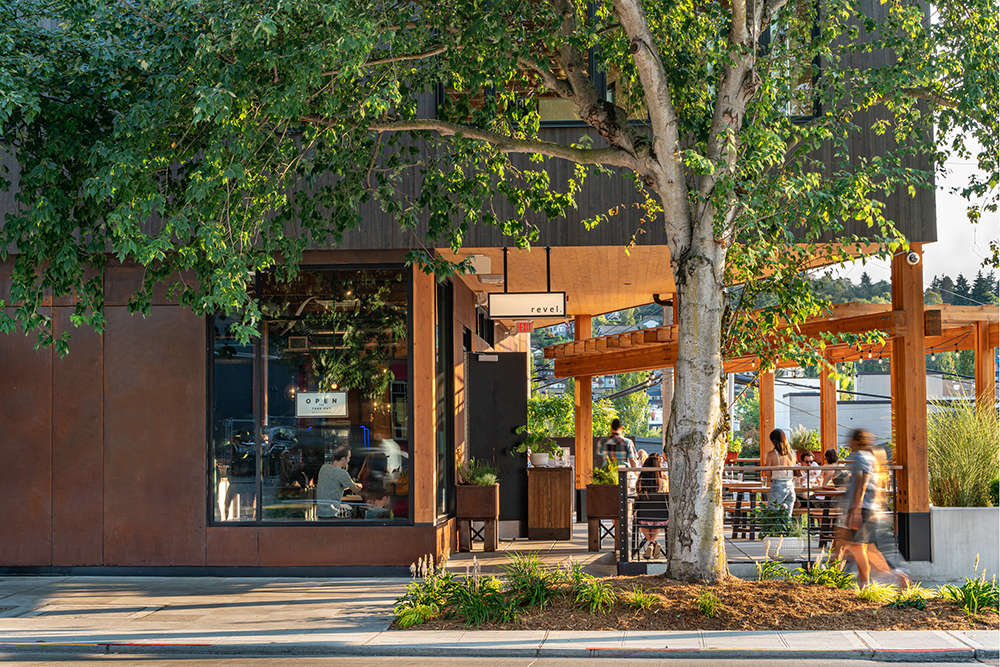By Jeff Reibman
Jeff Reibman is a senior principal and equity partner, leading the firm’s affordable housing and senior housing practice as well as mixed use, mid-rise teams.
The content for this article was originally published in the Daily Journal of Commerce Affordable Housing Special Section on November 21, 2024.
Intention, input and observation early on can help architects create buildings that strengthen connection and well-being.
In February, I wrote in this publication about the need to invest in our health through housing. One of the three pillars of design for human health and well-being is designing for community.
Today, we look specifically at design strategies to support community building. While I will focus on mixed-use housing design, many of these same principles can apply in workplaces and other project types as well.
Why design for community matters
Americans report feeling lonely and disconnected in ever higher numbers. The influences of technology, the pandemic, and our highly mobile society have all made it harder to establish and maintain meaningful connections.
Research points strongly to a connection between loneliness and our physical health, particularly the negative effects of long-term loneliness and isolation on a broad range of illnesses, from heart problems to depression and cognitive decline. Conversely, those reporting a strong sense of community and belonging have been found to have better physical and mental health outcomes, leading to a higher quality of life.
Before you begin
First, recognize the existing community around your future project. Don’t limit your definition of community to only the new building users.
Most sites will have existing community networks surrounding them, and possibly even already using them. Existing businesses may be important gathering places and even a seemingly vacant lot may serve as a play space. These gathering spots, referred to as third places, are essential for finding the people we connect with outside of work and home.
Effective community engagement before the project begins can reveal opportunities, build support for coming development, and help inform the design for better integration. Find out what is successful and useful around the site now, and what additional retailers or services the community needs. Your future building users will probably need them too.

Fremont’s Cedar Speedster connects a micro-community of tenants and patrons with porous public spaces that engage the neighborhood.
(Photo by Built Work Photography)
Finding a way to provide something of value to the existing community will create opportunities for people to connect to existing networks and is also good business. Building owners willing to invest in good retail design and curated tenants create additional amenity and positive branding for their buildings while knitting building users together with the existing community.
Happy little accidents
Buildings and their surroundings are full of small opportunities to bring people together. At their worst, these spaces can actually discourage interaction. Cramped, uncomfortable or barren spaces can make encounters difficult and awkward.
Simple design strategies can turn these small, accidental encounters into opportunities. Think about unprogrammed, high-traffic spaces like elevator lobbies, mail rooms and hallways where people are likely to see each other in passing. Don’t neglect the sidewalk out front, either. Make sure there is enough room for people to be comfortable with another person in the space, and that lingering to talk won’t impede circulation.
Incorporating elements of visual interest, like art or unique design elements can put people at ease and even serve as conversation starters. Pets can also be effective icebreakers. If they are allowed in your building, make sure the design encourages pet owners to use the same circulation spaces as everyone else. A few simple moves can be the difference between a friendly hello and someone just hurrying by.
Gathering spaces
We’ve all seen our share of well-intentioned community spaces that end up underused or feeling unwelcoming. Regardless of scale or budget, indoors or out, there are things we can do to make gathering spaces more effective and comfortable.
Start by recognizing opportunities for synergy. One successful space can help to activate another adjacent area. Place amenities near high-traffic areas and group spaces with different program goals together, providing visual connections when appropriate.
The ability to see into a room before deciding to enter is key. Seeing other people can help draw us in, signaling that this is a desirable place to be, just like a lively restaurant is more inviting than an empty one.
That said, it’s also important to provide transition spaces at entries. Give newcomers a place to stand and adjust rather than plunging right into the busiest part of a room. Similarly, edge space such as window seats and alcoves increase the versatility of a space. They can provide a comfortable opportunity to pull away and observe, have a more private conversation, or share a larger space with others who may be using it differently.
Biophilia, our natural affinity for nature and living things, is also a powerful design tool. Being close to nature helps put us at ease, making it easier to overcome the anxiety that might prevent us from meeting new people, or allowing us to have deeper conversations as we become more comfortable.

At the Rise on Madison on First Hill, tenants can experience biophilic benefits with access to a rooftop terrace with expansive views. (Photo by Moris Moreno)
Studies in academic buildings show more pro-social behavior in spaces with biophilic design incorporated. Locate gathering spaces to take advantage of natural light and views, particularly views of nature whenever possible. Even decorating with natural themes can have a positive impact. Connect indoor and outdoor spaces for greater activation and flexibility.
Feedback and iteration
Finally, recognize that one size does not fit all. Give people choices with different program elements and styles.
A post-occupancy study on a multi-family housing project we completed revealed an interesting result. The large community room was very successful at attracting kids, who enjoyed the vibrant design and used the TV screen for video games, but adults avoided the room because it was too loud. Dividing the area into two smaller spaces, with visual connection but some acoustic separation and different design themes would have been more successful and broadened its appeal.
On a subsequent project that also anticipated a lot of families, we adjusted our approach. Rather than one large community room, we took advantage of an opportunity to provide a smaller amenities space adjacent to the elevator lobby at every floor. Each space is programmed a little differently to encourage different groups to gather there. Post-occupancy studies can be a great tool for learning and improving our designs.
Shaping the built environment is a big responsibility. People in the AEC community recognize this and are proud of the opportunity to contribute something positive to our region for years to come. What could be more important than encouraging personal connections to strengthen the very fabric of the community we call home?
